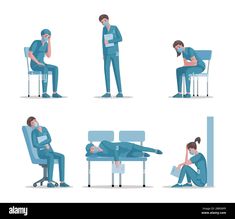Nurse Burnout and Its Devastating Impact

Table of Contents
The relentless demands of the healthcare profession take a toll. Nurses, the backbone of the medical system, face an insidious threat: burnout. Defined as a state of emotional exhaustion, cynicism, and reduced efficacy, nurse burnout is a growing concern with alarming prevalence. Studies reveal a staggering percentage of nurses experiencing burnout symptoms, leading to a ripple effect that impacts not only nurses themselves but also patient care and the healthcare system.
This pervasive issue carries a hefty price tag. Burnt-out nurses are more likely to withdraw emotionally from their patients, leading to decreased quality of care and potential medical errors. Furthermore, burnout fosters absenteeism and high turnover rates, creating staffing shortages that further strain the already overburdened healthcare system. The financial implications are significant, with burnout contributing to increased healthcare costs.
Recognizing the early warning signs of nurse burnout is crucial for prevention and intervention. By understanding the telltale symptoms that nurses experience, we can create a proactive approach to addressing burnout before it takes root. In the following sections, we will delve deeper into the multifaceted nature of nurse burnout symptoms, their progression, and individual variations in presentation. This knowledge empowers both nurses and healthcare systems to identify the silent threat and work towards fostering a supportive and sustainable work environment.
Understanding Nurse Burnout Symptoms through the Lens of the Nurse Burnout System

Nurse burnout, a complex and multifaceted syndrome, manifests in many ways. By exploring the emotional, physical, and behavioral symptoms through the lens of the Nurse Burnout System, we can gain a deeper understanding of this pervasive issue.
The Nurse Burnout System, developed by Christina Maslach and Susan Jackson, identifies three key dimensions of burnout: emotional exhaustion, depersonalization (cynicism), and reduced sense of personal accomplishment. By examining these dimensions, we can unveil the multifaceted nature of nurse burnout symptoms:
- Emotional Exhaustion: This core symptom often presents as feeling emotionally drained and depleted. Nurses experiencing emotional exhaustion may report feeling constantly tired and lacking the energy and motivation to care for patients effectively. They may struggle to concentrate, feel overwhelmed and irritable, and experience declining empathy and compassion.
- Depersonalization (Cynicism): This dimension manifests as a negative and detached attitude towards patients and the job itself. Burnt-out nurses may become cynical, viewing patients as objects or burdens rather than individuals. They may withdraw emotionally from patients, exhibiting a lack of care and concern. This detachment can lead to decreased communication and a decline in patient satisfaction.
- Reduced Sense of Personal Accomplishment: This final dimension relates to a decline in feelings of competence and self-efficacy. Nurses experiencing burnout may doubt their abilities, feel like their work doesn’t matter, and have a diminished sense of accomplishment. They may receive negative feedback or make mistakes due to fatigue, further reinforcing these feelings of inadequacy and decreasing job satisfaction.
The Progression of Burnout:
Burnout doesn’t develop overnight; it’s a gradual process with distinct stages. Early signs include mild cynicism, occasional fatigue, or difficulty concentrating. However, as burnout progresses, symptoms intensify and become more frequent. Emotional exhaustion becomes overwhelming, cynicism deepens, and self-doubt escalates. This can lead to physical manifestations like headaches, sleep disturbances, and even changes in appetite or weight. Behavioral changes also arise, with increased absenteeism, withdrawal from colleagues, and decreased productivity becoming more prominent. In severe cases, substance abuse or neglecting self-care become coping mechanisms, further jeopardizing the nurse’s well-being.
Individual Variations:
It’s important to recognize that burnout symptoms can manifest differently across individuals. Some nurses might primarily experience emotional exhaustion, feeling constantly drained and depleted. Others might exhibit more cynicism, becoming withdrawn and detached from patients. Additionally, personality traits and coping mechanisms can influence how symptoms develop. For example, a perfectionist nurse might experience heightened anxiety and self-doubt, while someone with a more optimistic outlook might initially mask symptoms and deny burnout altogether.
By understanding the different dimensions and stages of burnout through the lens of the Nurse Burnout System, nurses can develop self-awareness and identify their warning signs. Healthcare organizations can also use this framework to develop proactive strategies for early identification and intervention, fostering a supportive work environment that prevents burnout from taking root.
Risk Factors for Nurse Burnout through the Lens of the Nurse Burnout System

Nurse burnout doesn’t erupt in a vacuum; it’s a culmination of various factors that chip away at a nurse’s emotional reserves, sense of accomplishment, and well-being. By examining these risk factors through the lens of the Nurse Burnout System’s three key dimensions, we can gain a clearer understanding of how these elements contribute to burnout:
Workplace Factors:
- Demanding Workloads and Staffing Shortages: These factors directly contribute to emotional exhaustion. Being overburdened with patients and needing adequate support leaves nurses feeling drained and unable to provide optimal care.
- Lack of Control over Work Environment: When nurses feel they have little control over their schedules, work assignments, or decision-making processes, it fosters helplessness and reduced efficacy, negatively impacting their sense of accomplishment.
- Limited Opportunities for Advancement and Inadequate Support Systems: These factors diminish nurses’ sense of value and professional growth, contributing to cynicism and decreased perceived accomplishment.
Organizational Factors:
- Dysfunctional Communication and Unclear Expectations: Mixed messages, unclear protocols, and a lack of open communication create confusion and frustration, leading to emotional exhaustion and cynicism. Nurses may feel uncertain about their roles and unable to meet expectations, impacting their sense of accomplishment.
- Lack of Recognition and Appreciation: When nurses’ contributions go unnoticed or inadequately acknowledged, it fuels cynicism and diminishes their sense of personal accomplishment. Feeling undervalued and underappreciated demotivates nurses and weakens their commitment to their work.
Individual Factors:
- Personality Traits: Perfectionism can lead to unrealistic expectations and self-criticism, contributing to emotional exhaustion and feelings of inadequacy. Similarly, workaholic tendencies can exacerbate exhaustion, while difficulty delegating can create an overwhelming workload.
External Factors:
- Personal Life Stressors and Financial Difficulties: External stressors like family issues or financial problems can drain emotional reserves, further amplifying exhaustion. The need to juggle work demands with a challenging personal life creates an imbalance that can erode a nurse’s sense of accomplishment and contribute to burnout.
The Interconnected Web of Risk:
These risk factors often intertwine, creating a perfect storm that fuels burnout. For instance, a demanding workload and a lack of control over scheduling could lead to emotional exhaustion. If this isn’t addressed, it might manifest as cynicism towards the job and a decline in perceived accomplishment. Recognizing these risk factors and their influence on the Nurse Burnout System’s key dimensions empowers nurses and healthcare organizations to develop preventative strategies. By mitigating these risks, we can create a work environment that fosters emotional well-being, professional growth, and a renewed sense of accomplishment for nurses.
Building a Firewall: Strategies to Prevent Nurse Burnout

Nurse burnout is a complex challenge, but it’s not insurmountable. By implementing a multi-pronged approach that addresses individual and organizational factors, we can create a more sustainable and supportive work environment that empowers nurses to thrive.
Empowering Nurses: Individual Strategies
Nurses play a crucial role in preventing burnout. Here are key strategies to prioritize:
- Self-Care Practices: Prioritizing a healthy lifestyle is paramount. Sleeping, eating nutritious meals, and exercising regularly are essential for maintaining physical and emotional well-being. Incorporating relaxation techniques like mindfulness meditation or pursuing hobbies can further combat stress and promote emotional resilience.
- Setting Boundaries: Learning to say “no” is crucial. Nurses should communicate workload limitations and avoid taking on more than they can manage effectively. Setting boundaries protects nurses from feeling overwhelmed and contributes to a healthier work-life balance.
- Maintaining Social Connections: Strong social support networks are vital buffers against burnout. Nurses should cultivate supportive relationships with colleagues, friends, and family. Sharing concerns, receiving encouragement, and engaging in positive social interaction fosters emotional well-being and a sense of belonging.
- Professional Development: Investing in continuous learning can reignite passion for the profession. Pursuing continuing education opportunities, attending conferences, or learning new skills keeps nurses engaged and fosters professional growth. This, in turn, strengthens a nurse’s sense of accomplishment and combats feelings of stagnation.
- Seeking Professional Help: There’s no shame in seeking help. If nurses recognize early warning signs of burnout, they shouldn’t hesitate to seek support from therapists or counselors. Mental health professionals can equip nurses with coping mechanisms and strategies for managing stress and preventing burnout.
Building a Supportive System: Organizational Strategies
Healthcare organizations are responsible for creating a work environment that fosters well-being and prevents burnout. Here are key strategies:
- Supportive Work Environment: Promoting collaboration, teamwork, and open communication creates a sense of community and belonging. When nurses feel valued as part of a team, it reduces feelings of isolation and fosters a more positive work experience.
- Workload Management: Implementing strategies to ensure fair workload distribution and adequate staffing levels is critical. Overburdened nurses are more susceptible to burnout. Regular workload assessments, flexible scheduling options, and proper support staff can help alleviate stress and prevent emotional exhaustion.
- Recognition and Appreciation: Acknowledging and rewarding nurses’ contributions goes a long way. Developing systems for recognizing excellence, providing positive feedback, and offering opportunities for advancement reinforces a sense of accomplishment and motivates nurses to excel.
- Opportunities for Professional Growth: Investing in nurses’ professional development demonstrates value and fosters a sense of growth. Offering opportunities for skill development, participation in decision-making processes, or mentorship programs can increase job satisfaction and combat feelings of stagnation.
- Access to Wellness Resources: Providing Employee Assistance Programs (EAPs), on-site fitness facilities, or stress management workshops demonstrates organizational commitment to employee well-being. These resources empower nurses to prioritize self-care and develop coping mechanisms for managing stress.
A Shared Responsibility
Preventing nurse burnout requires a concerted effort from both nurses and healthcare organizations. By adopting these individual and organizational strategies, we can build a firewall against burnout, cultivate a thriving nursing workforce, and ultimately ensure the delivery of high-quality patient care.
Rekindling the Flame: Healing from Nurse Burnout
While prevention is ideal, sometimes burnout takes root. Early intervention is crucial to prevent nurse burnout from becoming chronic and causing lasting damage to well-being and professional fulfillment.
For nurses experiencing significant nurse burnout symptoms, taking decisive action is essential. This might involve:
- Taking a Leave of Absence: Stepping away from the demanding work environment can provide much-needed time for rest, self-care, and recovery.
- Seeking Professional Help: Therapists or counselors can equip nurses with coping mechanisms, address underlying stress causes, and develop strategies for effectively managing burnout symptoms.
- Refocusing on Self-Care: Prioritizing a healthy lifestyle with adequate sleep, nutritious meals, regular exercise, and relaxation techniques like mindfulness meditation is vital for restoring emotional and physical well-being.
Healthcare Organizations: Fostering Recovery and Return
Healthcare organizations have a crucial role to play in supporting nurses experiencing burnout and facilitating their return to practice:
- Providing Support Systems: Offering access to Employee Assistance Programs (EAPs), mental health resources, and stress management workshops demonstrates a commitment to employee well-being.
- Flexible Reintegration Plans: Developing personalized plans for reintegration can ease the transition back to work. This might involve reduced workloads, modified schedules, or opportunities for skill development to build confidence.
- Open Communication and Mentorship: Encouraging open communication and fostering mentorship programs can create a safe space for nurses to discuss their experiences and receive support from colleagues.
By acknowledging the severity of nurse burnout symptoms and offering comprehensive support systems, healthcare organizations can empower nurses on the road to recovery. Ultimately, creating a well-being culture that prioritizes individual and organizational strategies is essential for fostering a sustainable and supportive work environment where nurses can thrive and deliver exceptional patient care.
Conclusion
Nurse burnout, a pervasive threat characterized by emotional exhaustion, cynicism, and a reduced sense of accomplishment, poses a significant danger to the nursing profession and the well-being of patients. Left unchecked, these nursing burnout symptoms can lead to decreased quality of care, increased medical errors, and a revolving door of nurses exiting the workforce.
Addressing this crisis requires a shared responsibility. Nurses must prioritize their well-being by adopting self-care practices, setting boundaries, and seeking support when needed. Healthcare organizations must create a supportive environment through workload management, recognition programs, and access to wellness resources.
Nurses: Remember, you are the backbone of the healthcare system. By prioritizing your mental and physical health, you safeguard your ability to deliver exceptional patient care. Don’t be afraid to seek help if you’re experiencing burnout symptoms.
Healthcare Organizations: Investing in your nurses’ well-being is not an expense but an investment in the future of quality care. Implement strategies to prevent burnout and create a work environment that fosters well-being and professional growth.
Juggling the demands of a doctoral program in nursing can be a marathon, not a sprint. Research, coursework, clinical practice it’s no wonder you might feel swamped when it comes to writing exceptional nursing papers. But worry not, PhDnursewriter got you covered. there’s a wealth of resources available to empower you on your academic journey.





